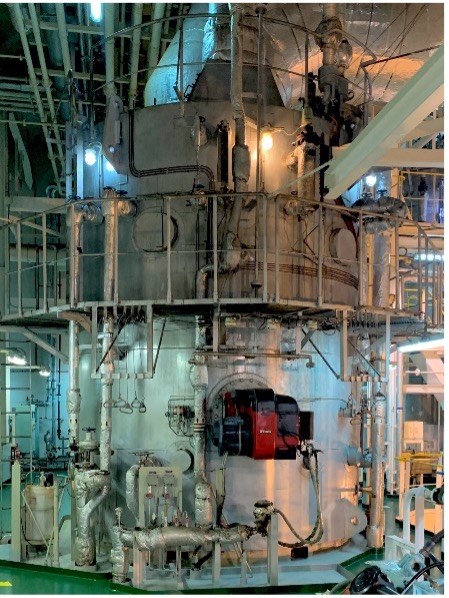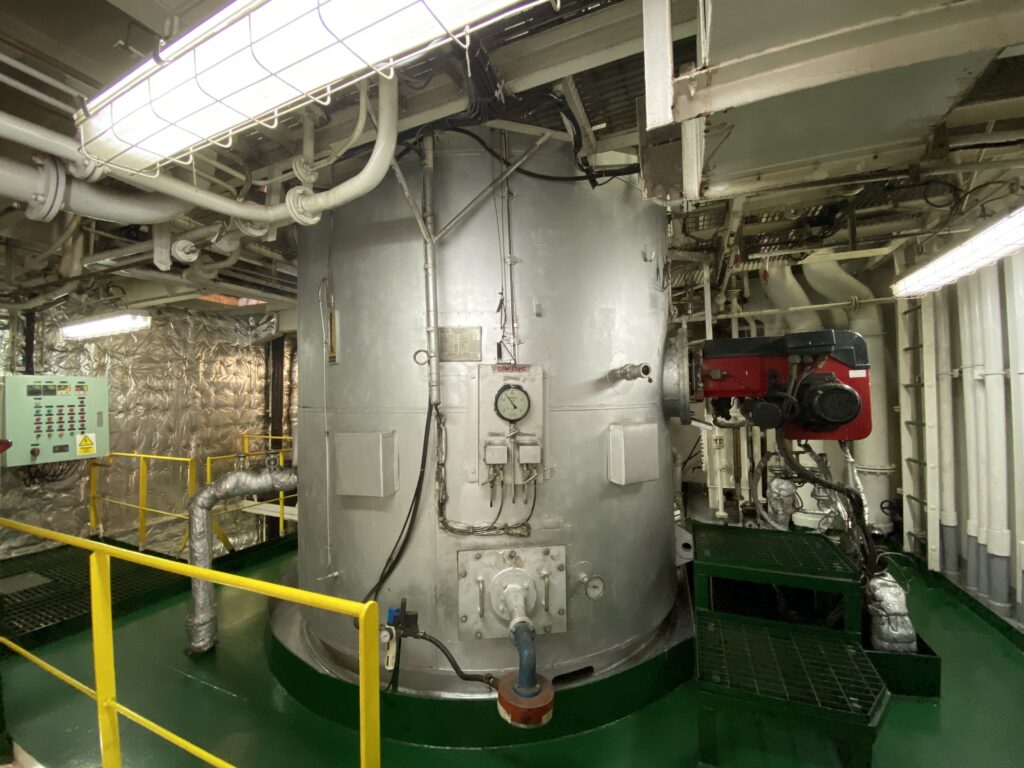A boiler, in a simple and broad sense, is a large container used to boil off water and create steam. On ships, the boiler utilizes the heat generated by the engine while running.
The engine cycle end product is the exhaust gases typically have a temperature range of 350 degrees Celsius to 400 degrees Celsius.

The Basic Principle Of Boilers In Ships
The heat contained by the exhaust gas passes along a bundle of tubes that are submerged in chemically treated water. This chemically treated water is maintained at a certain pH level or in layman’s terms acidity and alkalinity.
The water chlorine concentration is maintained at 0 ppm (parts per million), and lastly, the water cycling on a boiler system is treated with oxygen-scavenging chemicals to prevent corrosion inside the system.
This water when heated to 100 degrees Celsius or 212 degrees Fahrenheit changes from liquid to gas state, referred to as steam. The steam is then fed to various consumers, the steam when used and cools down goes back to its liquid state and then is called condensate water.
The pressure in the system pushes this condensate water back to a collecting tank called a condensate tank. The condensate tank holds the water for the next cycle. When the boiler drum water level gets low a feed pump sucks the water and fills up the boiler drum to create steam.
Ships usually have a main and auxiliary boiler. The main boiler uses the exhaust gas created by the main engine of the ship while the auxiliary boilers are boilers that use the exhaust gases produced by auxiliary engines/ generators.

The steam is continuously used aboard and so when the engines are not working an electric burner takes over to maintain the steam generation and pressure in the system. In addition, main boilers are referred to as composite-smoke boilers.
What Is The Use Of A Stream Onboard Ships?
Steam is important in a ship’s operation mainly because it provides heating for the fuel treatment process. In the fuel treatment process, especially heavy fuel/bunker fuels are sticky and very viscous at low temperatures this creates a dilemma in transferring between tanks and so to feeding it to the consumers.
With steam, the hot gases are fed to the steam coils installed inside the tank to raise the fuel temperature. As the fuel temperature increases the viscosity gets lower thus making it easier for pumps to transfer the fuel from one tank to another.
For fuel purification, the purifier needs the fuel to be at 98 degrees Celsius (for heavy fuel) and 60 degrees for marine diesel fuel.
Another essential application of steam on board is during winter the sea chests get frozen by ice. The steam when fed to sea chests breaks down the ice accumulation to provide flow to the seawater cooling system.
In domestic applications, the steam is also used to heat potable water on board to provide hot water for the vessel crew.
- Sustainable and Luxurious: Discovering Split’s Yachting Paradise – April 26, 2024
- MarineTraffic vs VesselFinder: Which Is Better Vessel Tracking Service? – February 14, 2024
- Port Costs: A Comprehensive Guide to Port Dues and Fees for Cargo Ships – February 12, 2024



